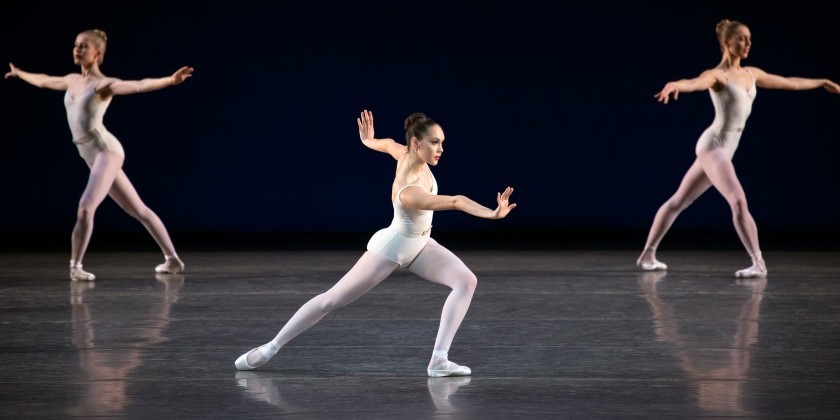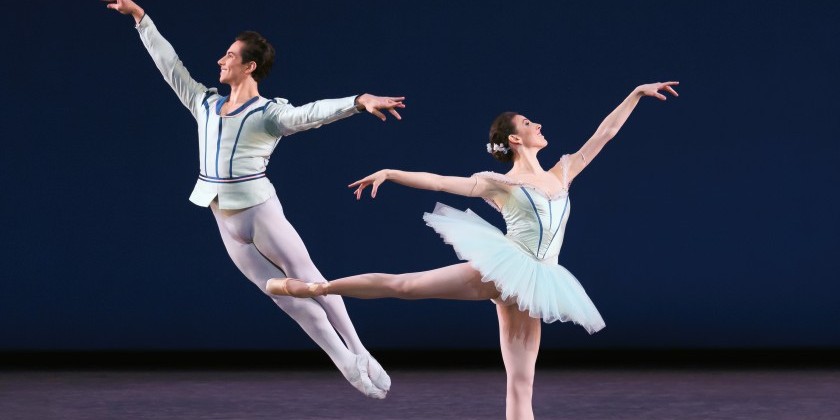IMPRESSIONS: New York City Ballet at David H. Koch Theater/Lincoln Center – Fall 2021 Season

October 5, 2021, at 7:30 p.m.
Monumentum Pro Gesualdo/Movements for Piano and Orchestra (Stravinsky/Balanchine)
Rotunda (Muhly/Peck)
Chaconne (von Gluck/Balanchine)
Djerassi Award to Wendy Whelan October 4, 2021
At an intimate gathering at the home of Margo and Mitchell Blutt on Monday evening, Kathryn Roszak presented the "Women Directors, Choreographers, and Composers Award" to New York City Ballet Associate Artistic Director Wendy Whelan. Co-sponsored by the Djerassi Resident Artist Program, the award honored Whelan for the advancement of women in the field of choreography. Commissioned choreographers of the season Sidra Bell and Andrea Miller lauded Whelan for her vision and support. Whelan spoke of the importance of diversity both on- and off-stage and underscored her commitment to women as part of the creative force for the company.

On Tuesday night at the ballet, the commitment to diversity may not have been obvious, but explained itself if one was familiar with the company years ago, when only token persons of color took the stage. While now still barely a handful of the featured corps are minorities, the increase presents a welcome change. Hopefully one day NYCB will represent our multicultural society on the stage at Lincoln Center.
Led by conductor Clotilde Otranto, the evening featured works by male composers and choreographers.
Balanchine’s 1960 work to Stravinsky’s Monumentum Pro Gesualdo, shows a central male/female pair flanked by two other couples with another four couples beyond them. This ascetic ballet pays homage to hierarchy not only in formation, but also in its execution. The central pair initiates a movement, the two couples follow, and the four couples complete the fragmented canon, which always ends after just a few bars in unison movement.
The configuration changes to a simple central duo with three pairs to either side in the work’s second movement. While the theme of a fragmented canon continues, the work stalls. Neatly finishing each phrase before another one begins, the dancers are too tightly hemmed in by the brevity of each idea to make any movement sing or resonate.

In the work’s final section everyone faces the downstage right corner side by side from a diagonal line. The central couple yet again initiates the movement phrase, which travels from the center of the line to its outsides. Eventually the diagonal line dissolves and the corps forms a square. With marching-band precision, the dancers shift this configuration and the men take turns catching Mira Nadon from the hands of Ask la Cour before they all assemble in the diagonal line again. The women slide down to the floor and the men kneel with their arms saluting the corner. Streamlined costuming enforces the somewhat clinical look. While the men wear black tights, tops, socks and shoes mirror the bright white of the women’s short ballet skirts, leotards, tights and pointe shoes.
Nadon and la Cour return for Movements for Piano and Orchestra and a new group of six women in plain white leotards sans skirts, (but still sporting white tights, and white pointe shoes as in Monumentum) surround them. The group, split in three and three, might not seem much more than plain window dressing, but the syncopated rhythms and corresponding movements let the corps dancers breathe a bit.
Short solos for the central pair only exist to prepare for the duet that follows. Here the deliberate, calculated partnering does not hide gestures of support as in classical ballet. Instead, the choreography showcases the maneuvers in clear view and allows surprising and intricate shapes to develop. La Cour assists Nadon assuredly and gracefully.
A circle of women forms around him while she waits (downstage left) for his solo to end. Their subsequent approach and separation only serve to reverse the picture. La Cour waits for Nadon — you guessed it — downstage right. After some more exquisite yet emotionally distant partnering work, the couple ends the piece in close proximity. He kneels facing upstage gazing toward her; she stands upright looking over him. The ballerina is celebrated as the admired one who gives her blessing before the curtain descends.

Suzanne Farrell and the late Jacques d’Amboise originated the roles in 1963. La Cour will take his final bow on Saturday night. An elegant dancer who joined the company in 2002 and distinguished himself as a wonderful partner to many ballerinas even before becoming a principal in 2013, he will be missed by many balletomanes.
Justin Peck’s Rotunda, from last year and to a commissioned score by Nico Muhly, at first appears to be the fresh breeze we have been waiting for. After Gonzalo Garcia is shown by himself lying on his back as if he were dreaming, a group of merry contemporaries claim the space. They form a circle, jump, and lift one another effortlessly with a joyful exuberance. If this positive view of life seemed hopeful at its premiere, just a good two weeks before the city came to a halt, now the celebratory communal energy casts away doubts about the future.
Most of the performers sport leotards with tights over them, which is not always a flattering look; while others wear the type of training gear that make me think of dancers on a cigarette break. The costume credit goes to Reid Bartelme and Harriet Jung. Mark Stanley creates the lighting as he does for the rest of the evening.
To highlight the community feeling as well as the title of the piece, the dancers end the opening section in a circle out of which a trio for Indiana Woodward, Daniel Applebaum, and Jovani Furlan emerges. Woodward is the center of attention and Furlan her main partner. Applebaum often repeats what Furlan has showed, but he also dances and stretches around and in between the partners in his appealing and elegant manner.

The trio finishes with other dancers coming into the space and building yet another circle. This time Miriam Miller and Adrian Danchig-Waring are the ones left to dance. The beauty of these two mesmerizes, but, in the end, he leaves the space while the incoming group absorbs her. This poignant moment stands on its own without any doggedly programmatic circle.
A solo for Sara Mearns ends with a whirlwind of space-eating piqué turns. A quintet for two men and three women plays once again inventively with the imbalance of numbers. Robbins’s Dances at a Gathering comes to mind, which after all was that choreographer’s homage to community. A group circle leads into a pas de deux for Mearns and Gilbert Bolden lll, for which the backdrop lowers to half black. The effect creates intimacy. But when the blackness invades even more space in the background during Garcia’s solo, a feeling of wistfulness and reflection sets in.
Is this the end of a day or a life? Muhly’s chords are droning and Garcia resumes his initial position. Was it a dream? Is there a new morning? Sure enough, the blackness lifts; the dancers jump with joy and lift with ease; and as Garcia turns a circle forms. He leads a new movement phrase and others follow before they run off. As Garcia sprints toward the audience, the last bit of darkness on the backdrop transforms to a bright promising glow.
The program concludes with Balanchine’s Arcadian Chaconne to von Gluck’s music. Tyler Angle partners Teresa Reichlen so generously and intuitively that she allows herself to open and shift her torso off-center whenever he supports her. A gorgeous sight!













